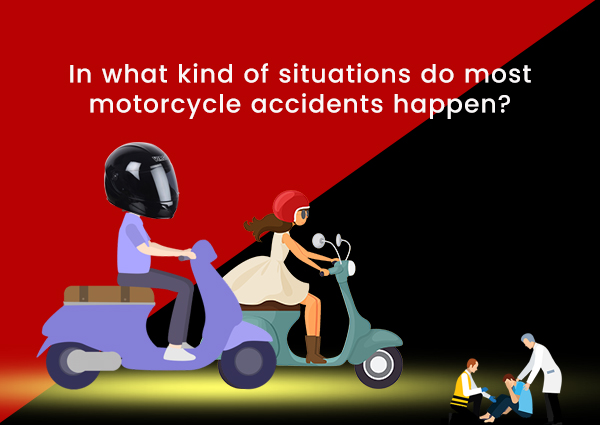In What Kind Of Situations Do Most Motorcycle Accidents Happen
In the following, we will be discussing an important topic that is “In what kind of situations do most motorcycle accidents happen?” and can discuss it in detail within the article. Motorcycle accidents, though not necessarily more frequent than other kinds of accidents, are more likely to result in serious injury or death.
According to the federal government, per mile traveled in 2006, there were thirty-five times more deaths from motorcycle accidents as compared to car accidents. Because of these alarming statistics, it pays for motorcyclists to learn about the most frequent causes or in what kind of situations do most motorcycle accidents happen and then use this information to reduce their level of risk.For this motorbike helmet manufacturers are doing a great work.
Motorcycles in Head-On Collisions
Crashes involving motorcycles and other vehicles account for fifty-six of motorcycle accident deaths. In the vast majority of these accidents, the car strikes the motorbike from the front –78% of the time. (The car strikes the motorbike from the rear only five-hitter of the time.) Head-on collisions between a car and motorbike are usually fatal to the motorcyclist.
Cars Making Left-Hand Turns
The single most dangerous situation for motorcyclists occurs once cars are making left-hand turns. These collisions account for 42nd of all accidents involving a motorbike and car. Usually, the turning car strikes the motorbike when the motorbike is:
- going straight through an intersection
- passing the car, or
- trying to overtake the car
These forms of accidents are common between 2 cars as well, however, the motorcycle’s smaller size makes it even less visible to the turning vehicle. Motorcycles that pass cars within the same lane are even more vulnerable –cars don’t expect and are often surprised by, such motorcycle maneuvers.
Almost always, a vehicle that hits another vehicle while making a left-hand turn is found at fault for the accident. However, if the motorcyclist was speeding or was in the wrong lane, the motorcyclist may be partly at fault for the accident. In most states, this means the motorcycle riders will get less compensation from the driver of the car for injuries as well as damages caused during an accident. In a few states, the motorcycle riders’ behavior could bar recovery altogether.
Motorcycle Lane Splitting
Lane splitting happens when a motorbike drives between 2 lanes of stopped or slowly moving cars, typically in traffic jams. Lane splitting is a common reason for motorbike accidents due to many factors:
- The close proximity of the cars to the motorbikes
- The reduced space the motorbike has to maneuver, and
- The fact that the cars do not anticipate that any vehicle/motorcycle will be passing them in slowed or even in stopped traffic
If an accident happens while a motorbike is lane splitting, whether the motorcycle or car is at fault depends on whether lane splitting is permissible in that state, the views of the police officer as well as judge on lane splitting, and the actions of both the driver of the car as well as motorcycle rider prior to the accident.
Motorcyclist Speeding & Alcohol Use
About half the accidents involving a single motorbike are caused by speeding or alcohol use. This statistic is not surprising and these factors play a large role in accidents among cars and other vehicles as well. However, because motorcycles do not provide a lot of protection to the rider, crashes involving speeding or alcohol are much more likely to result in death or serious injury.
Collisions Between Motorcycles And Fixed Objects
Motorcycle collisions with fixed objects account for 25% deaths of motorcyclists but in case car crash deaths only 18%. Again, because the motorcycle rider is not surrounded by a box of metal and is probably going to be thrown very far and hard, such accidents are more deadly when riding a motorbike.
Road Hazards Facing Motorcyclists
Motorbikes face higher dangers from road hazards than do cars as well as other vehicles. Due to the smaller size as well as less stable nature of the motorcycle, slick pavement conditions, potholes, dead animals, uneven heights between lanes as well as other irregularities or unexpected objects in the road pose a serious and big safety threat to motorbikes.
High-Performance Motorcycles
High-performance motorcycles or motorbikes, although comprising a small portion of the overall number of motorbikes on the road, account for a disproportionate number of motorcycle/motorbike accidents. These motorcycles fall into 2 categories: supersport motorcycles and sport motorcycles.
- Supersport motorcycles. Supersport motorcycles or motorbikes are built on racing platforms that are modified for highway use. Because these motorcycles are light-weight and have high-horsepower engines, they can go extremely fast — up to 160 mph. Most supersport motorbike riders are under the age of thirty, another contributing factor to the higher accident rate since younger motorcycle riders tend to be less cautious and take more risks than older riders.
- Sport motorcycles. Sport motorcycles are similar to supersport motorcycles but have a lower power to weight ratio. Drivers of sport motorcycles tend to be under the age of thirty-four. The death rate among riders of supersport motorbike accidents is four times that of riders of conventional motorcycles, like cruisers, standards, and touring motorcycles. The riders of the more conventional motorcycles are also older –usually age forty and above. The death rate among riders of sports motorbikes is 2 times that of standard motorcycle riders.
Motorcyclists are more at risk for fatal or serious accidents on the road than are drivers. Yet, motorcycle riders will increase safety by being aware of the common causes of accidents and taking steps to reduce or avoid the danger, whether it be taking extra care when anticipating road hazards, lane splitting, or resisting the temptation to speed.


